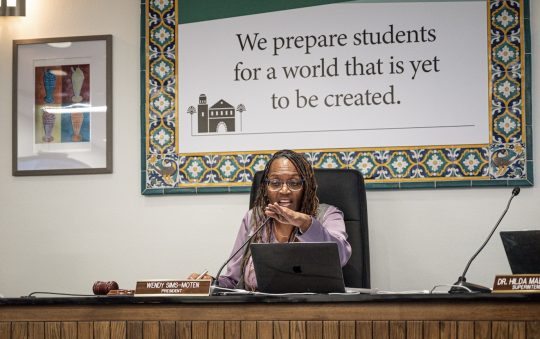Using Data and Research to Ensure the Success and Retention of Black Students

Being involved in students’ academic journey is one of the best parts of my job as President/Chief Executive Officer of Compton College. Many students set goals and find their path right away, but research shows that Black students are often left behind. In addition, the COVID-19 crisis exposed inequalities in education, and Black students were disproportionally affected; many were unable to continue their education due to loss of income, COVID-19 cases, the percentage of COVID-19 related deaths in our communities, and other factors. But the fact is, the success of Black students was already declining even before the COVID-19 pandemic. Taking a comprehensive look at the collegiate success of Black students requires a data-driven approach while also listening to our students to learn precisely what they need. In this second article of my “Unapologetically Fighting for Black Student Success” series, I will share data, highlight what we are doing at Compton College, and discuss how we can increase the retention and success of Black students today and into the future.
Reviewing the Data
After more than a year of dealing with the many challenges resulting from the COVID-19 pandemic, our students and our institution face new barriers in meeting achievement goals pertaining to student enrollment, success, and retention. Food and housing insecurity added to the stress of learning in a new virtual setting. Students faced limited access to technology, lack of support, a disconnect from their peers, isolation, fear, and more.
At Compton College, the success rate of Black students was just 60% in spring 2017. This number began decreasing and by spring 2020, had fallen to 51%. Similarly, retention rates for Black students were at 77% in spring 2017, and by spring 2020, they fell to 68%. The success rate (-16%) and retention rates for Black men (-15%) showed an even more significant decline from spring 2017 through spring 2020. This data can guide our efforts to make changes by showing the need for support and intervention. An excellent place to start is within the Guided Pathways Framework. Research shows that the practices used within the Guided Pathways Framework can help students complete academic goals faster. In fact, community college students are more likely to transfer to a four-year college or complete a degree if they set an academic plan early on. The important part of this framework is that everyone in the college community plays a role in student success.
Prioritizing Funding
Now that we have researched and identified barriers and challenges, what can we do to ensure the success of Black students? It is time to prioritize their achievement by providing intervention and support programs. And this takes funding. Budgets are a statement of values: If we value Black student success, we build budgets that support student success. According to the report “Follow The Money: California Systematically Underinvests in Black Degree Attainment,” higher education investment is not equitable across racial/ethnic groups. California Community Colleges enroll the vast majority of the state’s students while also disproportionately enrolling Black and Latinx students. Yet, California Community Colleges are funded at lower per-student levels than California’s other higher education systems. In fact, the state invests half the amount per community college student compared to their counterparts in the University of California system.
The California state budget has new money available to fund basic needs and affordability, workforce preparation, and for diversity and inclusion. Furthermore, the federal government has provided colleges and universities with new financial resources. So far from the federal government, Compton College has received a total of $2.5 million in Coronavirus Aid, Relief, and Economic Security Act funding, of which $2 million was set aside to provide students with direct emergency aid, including grants for food, housing, course materials, technology, health care, and child care. We are also accessing funds from the Higher Education Emergency Relief Fund of $6.3 million and the American Rescue Plan Fund of $11.5 million. In total, with the federal funding, we anticipate disbursing a total of $9.5 million in emergency aid to Compton College students.
If something is important, you prioritize it, and you fund it. As colleges and universities receive funding in these areas, “Race-Consciousness” decisions must be made in terms of how to serve students of color best. As defined by research from Dr. Frank Harris and Dr. J. Luke Wood from San Diego State University, “Race Consciousness” recognizes the realities of race for people of color and the ways in which institutional racism shapes educational access, opportunity, and success in both historical and contemporary U.S. contexts.
Putting Information into Action
At Compton College, we are doubling down on our need to boost Black student achievement by hiring a director of Black and Males of Color Success funded for the first two years through the American Rescue Plan Funds. This new position will be integrated into our Guided Pathways Framework work and help ensure that Black and Males of Color students have support in all aspects of academic life. The director will also provide professional development activities for faculty, staff, and managers/supervisors. Our Males of Color Taskforce has also offered several recommendations that have already been established. However, much more work needs to be done. We have added a culture, diversity, and equity graduation requirement for all students. Working with the Compton Community College District Board of Trustees, we are examining our hiring practices to ensure an equitable process for managers/supervisors, faculty, and staff positions.
Since homelessness, unemployment, and food insecurity disproportionately affect students of color, this is an opportunity for Compton College to identify new ways to approach basic needs, including increasing emergency aid to students. We will also continue to provide free food delivery from Everytable and offer Uber Eats vouchers to students while working with the Los Angeles County Department of Public Social Services to ensure eligible students sign up for the CalFresh food assistance program. It is also a priority to ensure all students have the technology (laptops and headphones) and access to reliable internet outside the Compton College campus. Finally, making sure students have access to the COVID-19 vaccine and mental health services through our partnership with St. John’s Well Child & Family Center.
Closing the Loop
So now we have data, we have programs in place, but what do we know about the Black students behind the numbers? Funding and supporting programs that provide personalized and targeted interventions are essential to student success. We see the success through our campuswide events, implementing the Guided Pathways Framework, and the emergency aid provided to students. However, we still have much more work that needs to be done in support of Black students. Not just at Compton College but also other California community colleges and universities.
As we utilize these new state and federal funds, we need to be thinking about all Black student success, not just a few hundred in a particular program. Offering a safe space for all Black students to pursue their education, so they have a chance to excel and be seen for who they truly are is an important goal for colleges and universities. They say it takes a village, and that is absolutely true. Black students need mentors, role models, and others to look to for guidance in their academic and career journeys. It’s time for alumni to step in and help current students and hold colleges and universities accountable for Black student success. It’s time for us to motivate and mobilize the village. I will continue this topic in my story next week.







